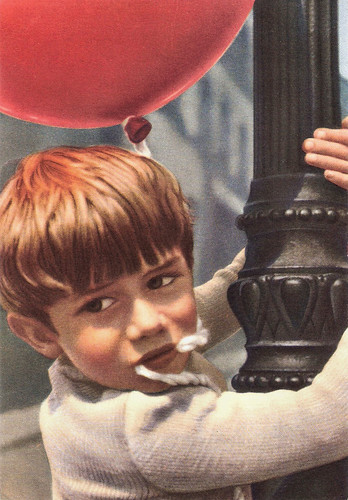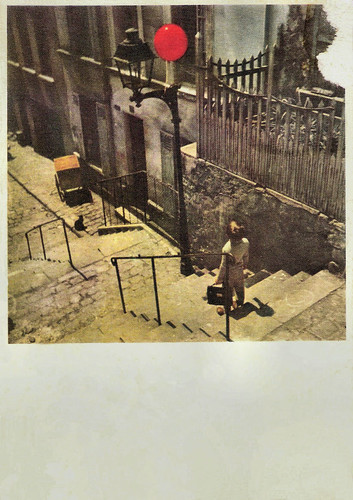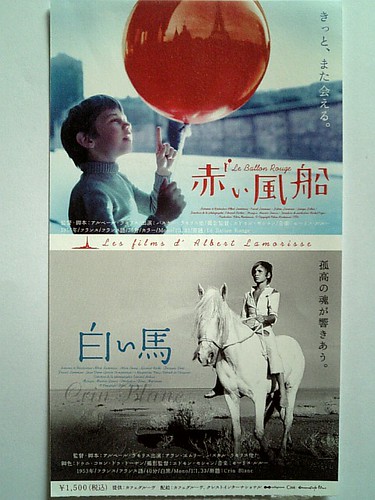French child actor Pascal Lamorisse (1950) is known by film lovers all over the world because of his parts in the short films Crin blanc: Le cheval sauvage (1953) and Le ballon rouge (1956), both directed by his father, Albert Lamorisse.

Italian postcard in the series Piccoli uomini nel cinema by Ed. Villaggio del Fanciullo, Bologna. Photo: Cino del Duca. Publicity still for Le ballon rouge/The Red Balloon (Albert Lamorisse, 1956).
Pascal Lamorisse was born in 1950. He is the son of film director Albert Lamorisse, who began his career as a photographer but turned to directing short films in the late 1940s. His first film was Bim (1951) about an Arab boy and his donkey. Remarkable is the poetic quality of this film and his later work, always involving the fantasy world of children.
When Pascal was only three he made his film debut in his father’s second film Crin blanc: Le cheval sauvage/Wild Stallion (1953). He played the little brother of the lead figure, the fisher boy Folco (Alain Emery).
The story is situated in the Camargue, in the south of France where the river Rhone meets the Mediterranean Sea. Herds of wild horses roam the tidal marshes. Ranchers seek to capture a white stallion with a long mane called Crin Blanc (White Mane), which is the leader of a group of wild horses. But Crin Blanc escapes capture time after time.
Folco witnesses the horse's furious fight for its freedom and makes friends with the horse after the ranchers supposedly give him up to whoever can capture him. They change their minds when they see the boy has tamed Crin Blanc and take off after the horse again, with the boy on his back. Both boy and horse, fed up with the continual fight for freedom and peace, and the duplicity of men, head out to sea as the men plead with the boy to turn back.
The short 40-minute film was the winner of the Grand Prix for Best Short Film at the Cannes Film Festival of 1953 and was nominated for the Best Documentary BAFTA Award in 1954. Howard Schumann at IMDb calls it ‘A truly gorgeous film’: “The ending is dark, perhaps too dark for many children, demanding of them a complexity that they perhaps are incapable of at a tender age. Yet the film does not patronize, introducing the viewer to the notion that standing up for what is right regardless of the outcome is one of the most important things in life and does not depend on age or strength. The poetic narration, delivered by Jean-Pierre Grenier and co-written by the acclaimed author and film critic James Agee, adds an extra dimension of sensitivity to the film that the viewer, whether child or adult, can immediately respond to.“

French postcard by F. Hazan Editeur, Paris, no. 1. Photo: Albert Lamorisse, 1956. Publicity still for Le ballon rouge/The Red Balloon (Albert Lamorisse, 1956). Caption: "Decouverte de ballon". (Discovery of the balloon).
Pascal and Albert Lamorisse are best known for their next film, the beloved urban fairy tale Le ballon rouge/The Red Balloon (1956). Pascal plays a little boy who is followed around the streets of Paris by a large red balloon, which seems to have a will of its own. The balloon colours the boy’s otherwise dreary, grey days. It follows him to school, to the bus, and to church. Boy and balloon play together in the streets of Paris and try to elude a gang of boys that wants to destroy the balloon.
Renaldo Matlin at IMDb: “The vivid colors and the wonderful use of Paris scenery is only part of the experience, another large part is the touching performance by the director's six year old son Pascal in the lead (how lucky he didn't fall and break his neck in that opening scene where he finds the balloon!). The look on his face in the final scene is every bit as heartbreaking as that of Jackie Coogan in Chaplin's legendary The Kid.”
Pascal’s sister, Sabine, portrays a little girl. Le ballon rouge is a short film of only 34 minutes, without dialogue. It is filmed for the most part in the Belleville area of Paris. It is now a colourful record of Belleville while the area had fallen into decay by the 1960s, prompting the Parisian government to demolish the area as a slum-clearance effort.
Albert Lamorisse took home another Grand Prix from the Cannes Film Festival but this time he also won an Academy Award for writing the best original screenplay in 1956. Throughout the 1960s, 1970s, 1980s and early 1990s Le Ballon Rouge was popular in elementary classrooms all over the world, but not in France.
D.B. Dumonteil at IMDb: “Since its success in the Festival de Cannes 1956, Albert Lamorisse's short film was relegated to purgatory. Often dismissed by French critics as bland, mushy and arty, it sank slowly but inexorably into oblivion. The other countries have always had a warm spot for it. And they are right. If you were a young student in the late fifties/early sixties, Le ballon rouge was one of your initiation books. After 1968, the story almost completely disappeared from textbooks. Actually, it was new wave ‘avant l'heure’! Filmed in the streets of Paris - as Varda, Truffaut and countless others would do afterwards - its form was innovative.”

Japanese cinema ticket for Crin blanc: Le cheval sauvage/Wild Stallion (1953) and Le ballon rouge/The Red Balloon (1956). Source: ak.i. (Flickr).
Next, Pascal Lamorisse played a lead role in his father’s first feature film Le voyage en ballon/Stowaway in the Sky (1960). In this sequel to Le ballon rouge, Albert Lamorisse floats his public across the French countryside and town church steeples, brilliantly and colourfully photographed.
Hal Erickson at AllMovie: “Stowaway in the Sky is a disarmingly simple French-made children's story. The plot is implicit in the title: A small child, fascinated by a lighter-than-air balloon, clambers aboard. The balloon takes flight, lifting the child upward to an amazing adventure. The land-bound adults have conniptions as the balloon wafts by; the child has nothing more than a great time.”
The film was not a commercial success and it was Pascal Lamorisse’s last film. Albert Lamorisse retreated to documentary shorts. He was also the creator of the board game Risk. Originally, published in France in 1957, it was called 'La Conquête du monde'. It was eventually picked up by Parker Brothers, and sold in the United States under the name 'Risk'.
In 1970, 48-year-old Albert Lamorisse was killed in a helicopter crash in Iran while shooting a documentary near Teheran. Pascal Lamorisse and his mother later edited the film from Albert’s production notes. The resulting film, Le vent des amoureux/The Lovers' Wind (1978) is a visually stunning helicopter tour of Iran. It was nominated for an Oscar as Best Feature Documentary in the Academy Award ceremonies of 1979.
From then on Pascal Lamorisse disappeared in anonymity. In 2007, Hou Hsiao-Hsien directed Flight of the Red Balloon, a direct homage to Le ballon rouge and to Father and Son Lamorisse. That year Pascal Lamorisse did a short audio interview with NPR, where he talked about the re-release of Le ballon rouge/The Red Balloon and about his plans to do a sequel. This sequel hasn't happened yet.
Rerelease trailer for Le ballon rouge/The Red Balloon (1956). Source: MOVIECLIPS Classic Trailers (YouTube).
Sources: Hal Erickson (AllMovie), James Travers (French Films), Dustin Rowles (Pajiba), D.B. Dumonteil (IMDb), Renaldo Matlin (IMDb), Howard Schumann (IMDb), Wikipedia, and IMDb.
This post was last updated on 8 February 2025.

Italian postcard in the series Piccoli uomini nel cinema by Ed. Villaggio del Fanciullo, Bologna. Photo: Cino del Duca. Publicity still for Le ballon rouge/The Red Balloon (Albert Lamorisse, 1956).
Crin blanc
Pascal Lamorisse was born in 1950. He is the son of film director Albert Lamorisse, who began his career as a photographer but turned to directing short films in the late 1940s. His first film was Bim (1951) about an Arab boy and his donkey. Remarkable is the poetic quality of this film and his later work, always involving the fantasy world of children.
When Pascal was only three he made his film debut in his father’s second film Crin blanc: Le cheval sauvage/Wild Stallion (1953). He played the little brother of the lead figure, the fisher boy Folco (Alain Emery).
The story is situated in the Camargue, in the south of France where the river Rhone meets the Mediterranean Sea. Herds of wild horses roam the tidal marshes. Ranchers seek to capture a white stallion with a long mane called Crin Blanc (White Mane), which is the leader of a group of wild horses. But Crin Blanc escapes capture time after time.
Folco witnesses the horse's furious fight for its freedom and makes friends with the horse after the ranchers supposedly give him up to whoever can capture him. They change their minds when they see the boy has tamed Crin Blanc and take off after the horse again, with the boy on his back. Both boy and horse, fed up with the continual fight for freedom and peace, and the duplicity of men, head out to sea as the men plead with the boy to turn back.
The short 40-minute film was the winner of the Grand Prix for Best Short Film at the Cannes Film Festival of 1953 and was nominated for the Best Documentary BAFTA Award in 1954. Howard Schumann at IMDb calls it ‘A truly gorgeous film’: “The ending is dark, perhaps too dark for many children, demanding of them a complexity that they perhaps are incapable of at a tender age. Yet the film does not patronize, introducing the viewer to the notion that standing up for what is right regardless of the outcome is one of the most important things in life and does not depend on age or strength. The poetic narration, delivered by Jean-Pierre Grenier and co-written by the acclaimed author and film critic James Agee, adds an extra dimension of sensitivity to the film that the viewer, whether child or adult, can immediately respond to.“

French postcard by F. Hazan Editeur, Paris, no. 1. Photo: Albert Lamorisse, 1956. Publicity still for Le ballon rouge/The Red Balloon (Albert Lamorisse, 1956). Caption: "Decouverte de ballon". (Discovery of the balloon).
Le ballon rouge
Pascal and Albert Lamorisse are best known for their next film, the beloved urban fairy tale Le ballon rouge/The Red Balloon (1956). Pascal plays a little boy who is followed around the streets of Paris by a large red balloon, which seems to have a will of its own. The balloon colours the boy’s otherwise dreary, grey days. It follows him to school, to the bus, and to church. Boy and balloon play together in the streets of Paris and try to elude a gang of boys that wants to destroy the balloon.
Renaldo Matlin at IMDb: “The vivid colors and the wonderful use of Paris scenery is only part of the experience, another large part is the touching performance by the director's six year old son Pascal in the lead (how lucky he didn't fall and break his neck in that opening scene where he finds the balloon!). The look on his face in the final scene is every bit as heartbreaking as that of Jackie Coogan in Chaplin's legendary The Kid.”
Pascal’s sister, Sabine, portrays a little girl. Le ballon rouge is a short film of only 34 minutes, without dialogue. It is filmed for the most part in the Belleville area of Paris. It is now a colourful record of Belleville while the area had fallen into decay by the 1960s, prompting the Parisian government to demolish the area as a slum-clearance effort.
Albert Lamorisse took home another Grand Prix from the Cannes Film Festival but this time he also won an Academy Award for writing the best original screenplay in 1956. Throughout the 1960s, 1970s, 1980s and early 1990s Le Ballon Rouge was popular in elementary classrooms all over the world, but not in France.
D.B. Dumonteil at IMDb: “Since its success in the Festival de Cannes 1956, Albert Lamorisse's short film was relegated to purgatory. Often dismissed by French critics as bland, mushy and arty, it sank slowly but inexorably into oblivion. The other countries have always had a warm spot for it. And they are right. If you were a young student in the late fifties/early sixties, Le ballon rouge was one of your initiation books. After 1968, the story almost completely disappeared from textbooks. Actually, it was new wave ‘avant l'heure’! Filmed in the streets of Paris - as Varda, Truffaut and countless others would do afterwards - its form was innovative.”

Japanese cinema ticket for Crin blanc: Le cheval sauvage/Wild Stallion (1953) and Le ballon rouge/The Red Balloon (1956). Source: ak.i. (Flickr).
Le voyage en ballon
Next, Pascal Lamorisse played a lead role in his father’s first feature film Le voyage en ballon/Stowaway in the Sky (1960). In this sequel to Le ballon rouge, Albert Lamorisse floats his public across the French countryside and town church steeples, brilliantly and colourfully photographed.
Hal Erickson at AllMovie: “Stowaway in the Sky is a disarmingly simple French-made children's story. The plot is implicit in the title: A small child, fascinated by a lighter-than-air balloon, clambers aboard. The balloon takes flight, lifting the child upward to an amazing adventure. The land-bound adults have conniptions as the balloon wafts by; the child has nothing more than a great time.”
The film was not a commercial success and it was Pascal Lamorisse’s last film. Albert Lamorisse retreated to documentary shorts. He was also the creator of the board game Risk. Originally, published in France in 1957, it was called 'La Conquête du monde'. It was eventually picked up by Parker Brothers, and sold in the United States under the name 'Risk'.
In 1970, 48-year-old Albert Lamorisse was killed in a helicopter crash in Iran while shooting a documentary near Teheran. Pascal Lamorisse and his mother later edited the film from Albert’s production notes. The resulting film, Le vent des amoureux/The Lovers' Wind (1978) is a visually stunning helicopter tour of Iran. It was nominated for an Oscar as Best Feature Documentary in the Academy Award ceremonies of 1979.
From then on Pascal Lamorisse disappeared in anonymity. In 2007, Hou Hsiao-Hsien directed Flight of the Red Balloon, a direct homage to Le ballon rouge and to Father and Son Lamorisse. That year Pascal Lamorisse did a short audio interview with NPR, where he talked about the re-release of Le ballon rouge/The Red Balloon and about his plans to do a sequel. This sequel hasn't happened yet.
Rerelease trailer for Le ballon rouge/The Red Balloon (1956). Source: MOVIECLIPS Classic Trailers (YouTube).
Sources: Hal Erickson (AllMovie), James Travers (French Films), Dustin Rowles (Pajiba), D.B. Dumonteil (IMDb), Renaldo Matlin (IMDb), Howard Schumann (IMDb), Wikipedia, and IMDb.
This post was last updated on 8 February 2025.
No comments:
Post a Comment